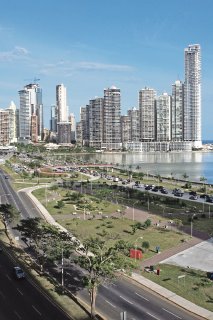
(International Business Times) It’s a bit Hong Kong. And a bit Dubai. With a little Gold Coast thrown in for good measure. But what are we doing on this bitty isthmus, anyway?
We came to Panama, the sinewy strip connecting The Americas, not really knowing what to expect. There’s a canal, yes. A very busy canal. That much we knew. But what about the rest of the story? What, for example, would the capital city look like?
Would it be a Managua-esque affair; a few scattered buildings quickly dissolving into sprawling shantytown suburbs dotted along potholed roads? Or would it be more like the other big cities of the former Gran Colombia; Bogota-like metropolises with charming old buildings and lazy plazas full of artists and half-drunk musicians?
Neither, it seems. We doubt there’s a building in all of Nicaragua the size of the hotel we’re staying at here in Panama. And it seems that anything older than, say, fifty years has been – or soon will be – swallowed up by all the shiny new glass and steel towers rocketing into the skies above.
Investment blogs and financial papers crow in unquestioning unison about the current and projected economic growth of Panama. Something called the ‘Latin Business Chronicle’ reckons this country will match Brazil’s supposed 10% growth rate over the next five years, making it the fastest growing economy in Latin America.
There’s also low unemployment (2.7%) and a free trade agreement with the US on which the ink is still wet. It ranks pretty well on touchy-feely lists too, like its 54th place on the Human Development Index. Then there’s the country’s unique position…and that canal.
But what does all this mean? What will it mean? We have no idea. A third of the people living in Panama do so in poverty. One in six qualify for ‘extreme’ poverty.
As always, it’s tough to get a read on a place until you visit. And even then it can become harder to see the real picture. One fellow lives in a tin shack. Another just bought a skyscraper. One woman scores a job at a swanky new hotel downtown. Another sweeps a floor made of dirt. One kid unwraps a new iPhone on Christmas morning. Another makes do with a stick and his own imagination.
A country can move in a ‘general’ direction, but the story has many faces, each of them different.
Measures like GDP and unemployment tell us things…but usually not the things we want to know…and almost never the things we’re told they’re telling us. Take that 2.7% unemployment rate, for instance.
That might seem good for a place like Panama. The official figure is four times that high in the US. Unofficially – as in, ‘really’ – it’s much, much higher. Still, most people would rather be “marginally employed” in Boston than fully employed in Bocas del Toro.
In the US, the unemployed can still get cell phones and free sandwich stamps at Subway. Meanwhile, Panama doesn’t even have an actual subway (though construction on a city metro is underway…)
It’s tough to spot trends in places like this but, on the surface, there looks to be an awful lot of construction going on…and a lot of vacant space. It’s probably too early to tell if Panama is a Hong Kong in the making…or a Dububble waiting to burst.
By Joel Bowman
The Daily Reckoning Australia